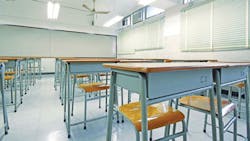School Design: Windows/Daylighting (with related video)
In the last decade, schools and universities have seen the light.
More and more education institutions and the architects that design their facilities have opted to incorporate strategies that bring daylight into instructional spaces, as well as other parts of a building. Daylighting appeals not only to building managers seeking to operate their facilities more efficiently, but also to educators hoping to provide the best learning environment for students.
A building that effectively uses available natural light to illuminate interiors will need less artificial light and be able to lower its electric bills. In addition, studies have indicated that students in classrooms with ample amounts of diffused daylight perform better in some academic subjects.
The Daylight Dividends research program, made up of a consortium of agencies, including the U.S. Department of Energy, has produced a guide for daylighting schools that can help schools and universities bring daylight into their learning spaces.
Before embarking on a daylighting initiative, facility managers must understand that installing additional windows in a classroom won’t necessarily bring about the benefits promised by proponents of natural light.
"If uncontrolled direct beam radiation is streaming through the classroom window and into a student’s face, the teacher will simply close the blinds and negate your daylighting strategy," the guide warns.
Low windows that provide a view from the classroom to the outside are beneficial because they enable students to have a connection to the outside environment, but such windows usually aren’t the ones that help create an effectively daylighted space.
Typically, the guide says, installing roof monitors should be the first daylighting strategy considered, followed by light shelves. Roof monitors with vertical south-facing glazing, properly sized overhangs and interior baffles have an advantage because they create uniform lighting throughout a space; can be used to illuminate spaces far from the perimeter of the building; create more diffuse, filtered lighting; and eliminate contrast and glare. However, roof monitors are feasible only in one-story buildings.
Light shelves, on the other hand, can be used on multi-story buildings, can bounce sunlight to the back of most classrooms and typically cost less than roof monitors. But because the daylight comes from only one side of a classroom, it is more difficult to distribute daylight uniformly.
Determining what are the most effective daylighting strategies will depend on the characteristics of a building—its dimension, orientation and layout. But the Daylight Dividends guide does offer general daylighting recommendations:
-
Avoid bright, visually exposed windows so there is not too much contrast between bright surfaces and darker surfaces.
-
Use light colors for interior finishes so that the daylight can be reflected throughout a space.
-
Use highly reflective ceiling tile to deliver daylight throughout a room.
-
When laying out a classroom, consider where the light is coming from and whether there is a potential for glare.
Designers also should make sure to take into account shading from adjacent buildings and trees when measuring how much daylight will be admitted through windows. The design should consider the reflectance of material in front of windows to determine the amount of daylight admitted into the building.
Kennedy, staff writer, can be reached at [email protected].
Related Video
Students in Kinard CARES demonstrate the daylighting features at Kinard Core Knowledge Middle School, Fort Collins, Colo.
About the Author
Mike Kennedy
Senior Editor
Mike Kennedy, senior editor, has written for AS&U on a wide range of educational issues since 1999.
